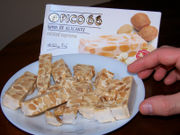
Turrón (Spanish), torrone (Italian), or torró (Valencian or Catalan), is a nougat confection, typically made of honey, sugar, and egg white, coated in crushed, toasted almonds, and usually shaped into either a rectangular tablet or a round cake. Nowadays it is mostly consumed as a traditional dessert for Christmas.
Turrón appears to be of Arabian origin; it is known definitely to have existed at least since the 16th century in the city formerly known as Sexona, later known by its Valencian name of Xixona (Jijona in Spanish), in the current province of Alicante. Turrón is now commonly consumed in most of Spain, some countries of Ibero-America, and in Rousillon (France). The Italian Torrone, quite similar to the Spanish turrón, is typical from Bagnara and Cremona.
Turrón may be roughly classified as:
- Soft (the Jijona variety): Based on a mass mixture of oil, honey, sugar, eggs and almonds which make up an easily edible brick.
- Tough (the Alicante variety): Made up as a compact block of whole almonds in a tough mass of eggs, honey and sugar.
Apart from the traditional Alicante and Jijona varieties, Agramunt and torró de gat (a variety from Cullera made with popcorn and honey) turrones are also highly appreciated.
There are many variations on this product. Marzipan (mazapan) with candied fruits, yema (egg yolk and sugar) and coconut are the most well-known, but in recent years there had been a great diversification and nowadays it is possible to find a great variety of flavours: chocolate with puffed rice or whole almonds; all kinds of chocolate pralines, with or without liquor, candied fruits or whole nuts; fruit pralines and even sugarless variations (sweetened with fructose or artificial sweeteners).
The quality of the product is determined by the quantity of almond in the mix. To be real turrón of Jijona, it has to have at least 64% almonds. The Alicante variety needs to have at least 60% almond.
The 16th century. Manual de Mugeres (a handbook of recipes for cosmetics and some foodstuffs) has what is probably the oldest extant Spanish turron recipe (also available in English). It calls for honey and some egg whites, cooked until it becomes breakable once cooled. Once the honey is caramelized the recipe suggests putting into it either pine nuts, almonds or hazelnuts, peeled and roasted. The mix is then cooked a bit further, and finally taken away from the fire and cut into "pińas" or slices.
External links
- (Spanish) Regulatory Council for Jijona and Alicante varieties
- (English)Turron Museum of Jijona Jijona , English-langauge website with a video of the city and the turron museum, from a local citizen
Categories: Christmas food
